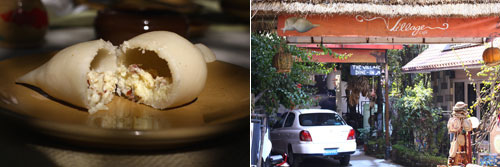
I first discovered yomaris as a kid when I was still the 4th grade. New Newar neighbors had just moved in, and on one fine chilly December day, they offered us a plate of white fish-like edibles. I vividly remember nibbling on the tail of one of those yomaris wondering what makes people like these bland-tasting rice-flour, only to dig in deeper and find the wonders of chaku and khuwa stuffed inside. My taste buds had discovered a new flavor that would absolutely turn into a favorite over the years that would patiently have me waiting for this particular time of the year to indulge in its sweet richness.
Yomari Punhi is the festive full moon day of December for the newari community. Yomari Punhi marks the end of the harvesting season, wherein Yomaris are prepared and shared among relatives and neighbors, and also offered to express gratitude towards Annapurna, the goddess of grains, for the rich harvest of the year.

A yomari is a steamed dumpling with an external shell made out of the flour of freshly harvested rice shaped like a fish with its insides filled with either chaku (molasses) or khuwa (sweet ricotta-cheese).Although a traditional Newari grub, the yomaris these days have evolved deliciously with a variety of fillings like chocolates, mushrooms and even meat.

The yomaris are prepared by rotating a dollop of rice flour dough in one hand and using the index finger of the other hand to create the desired hollow shape of the Yomari. The fillings are stuffed into the hollow before being closed in a similar manner so that the yomari takes the shape of a fish. This triangular shape is said to resemble the Shadokna, the symbol of Saraswati and wisdom. The raw dumplings are then steamed and served hot.

There have been ample discussions about whether a yomari is a dessert or a confection. Turns out the debate can now be rested as yomaris are, in true definition, confections. Yes, both confections and desserts are sweet but a dessert usually compliments a main course meal at the end. A yomari, in most cases, is a meal on its own and, of course, a sweet one with high liquid sugar content that makes it a confection.
The delicacy gets its name from two Nepal Bhasa words; “yo” meaning “to like” and “mari” meaning “bread”. In short, it just means a delicacy/bread that is popular.
Folklore has it that the festival of Yomari Punhi started from the ancient village of Panchal Nagar, now Panauti. When the married couple, Suchandra and Krita, experimented with their fresh yield of rice, what took shape was called a yomari. It was distributed among villagers and when presented to Lord Kubera, the God of wealth, who was passing by in disguise, he bestowed the couple with wealth.

The yomaris offered to the Gods are prepared on Yomari Punhi and not consumed on the same day, but only after four days marking the end of the festival. It is a belief that anyone who observes this festival for four days in December by preparing yomaris in the form of gods and goddesses will get rid of their poverty.
Most yomari houses sell yomaris within the range of Rs. 35-50 per piece. The prices vary according to the size as well as the fillings of the Yomari. The price might be a bit expensive for the proportion of the yomaris, but it is justifiable as all the ingredients used such as rice flour,chaku and khuwa are not so inexpensive themselves.
There are not many places that serve this newari delicacy, but listed are a few trusted houses that have been serving the best yomaris in town:

The Village Café: Located in Pulchowk, it is an initiation of Sabah Nepal which contributes to the economic and social growth of home-based female workers. The cooking and hygiene training of Sabah Nepal have enhanced the skills of these women, who make and serve some of the best yomaris in town. The Village Café not only serves chaku and khuwa yomaris, but also newer versions such as meat, mushroom and chocolate. They serve yomaris all year round and also organize a Yomari Festival during Yomari Punhi.
Nandini Food Court: Located in Swotha Square of Patan, Nandini Food Court has been a locals’ favorite when it comes to yomaris. It is mostly visited by students and tourists and also serves a variety of other Newari dishes.



